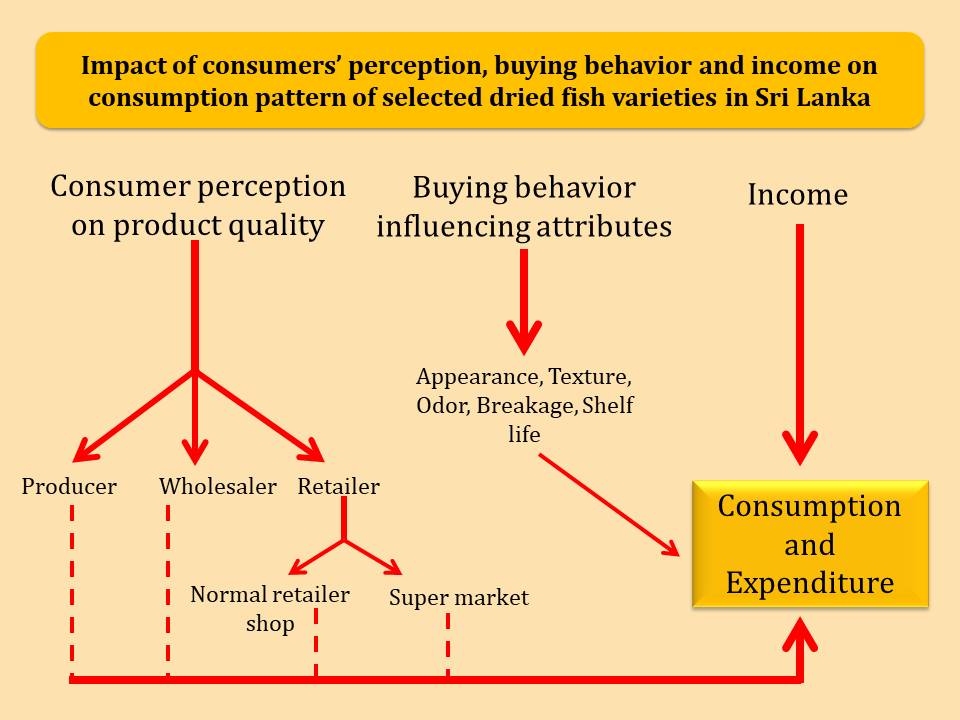Consumers’ perception, buying behavior and income on consumption pattern of selected dried fish varieties in Sri Lanka
Abstract
Dried fish consumption is ever becoming popularized locally and globally due to its micro-nutrient content, semi-perishability, and taste. The outcomes uncovered that physical quality attributes are the main choosing factors for dried fish. Perceptions and buying behavior of consumers are highly varied on dried fish varieties, purchasing level and quality attributes. Furthermore, studies on dried fish buying behavior, consumption patterns are lacking. Therefore, this study decided to identify the relationship between the level of dried fish consumption pattern over consumer’s income and to analyze consumers’ perception and buying behavior on selected dried fish varieties (sprats, skipjack tuna and smoothbelly sardinella) in Sri Lanka. Pre-tested structured questionnaire was distributed among 200 dried fish consumers by using Convenient and Snowball sampling in Kurunegala, Gampaha, Jaffna, Puttalam and Matara which represent the highest dried fish consumption and production districts in Sri Lanka. Secondary data was collected from the Department of Census and Statistics and Ministry of Fisheries and the Aquatic Resource Development on selected major animal protein sources during 2006-2019. Data were analyzed using descriptive and non-parametric statistics using Pearson correlation and Friedman test. The consumer preference is the highest for consumption of smoothbelly sardinella (Mean =2.95, p=0.00) than other two varieties. All perceived quality deterioration was observed along the supply chain. Consumers in Gampaha and Matara believe supermarkets (Mean> 3.13, p=0.00) while other all observed district believe producer level market (Mean >2.89) as the source for higher quality dried fish. Appearance (Mean> 3.79, p=0.00) is valued over texture, odor, breakage and shelf life while breakage (Mean< 2.82, p= 0.00) is indicated the least value by consumers in all five districts. Higher percentage share (36%<) of dried fish expenditure is captured by 1-4 income range of expenditure deciles that counts on 1-3 income range for consumption (43% <) of dried fish. Strong positive correlation between the percentage share of chicken consumption (0.777)/ expenditure (0.802) while negative correlation with the percentage share of dried sprats (-0.743)/ dried skipjack tuna (-0.798) consumption are observed against mean income in each expenditure deciles. In conclusion, the dried fish act as the main animal protein source for lower income households as giffen good. Appearance and texture are the main quality attributes perceived by consumer at buying. Consumers consider more on product and trader’s level quality when buying dried fish. Effective value additions and standardized handling practices need to be introduced and practiced to enhance the physical quality of dried fish along the dried fish supply chains. Further, decisions and policies need to be addressed by identifying consumer preferences and buying behavior to establish the stable industry.

Downloads
Published
How to Cite
License
Copyright (c) 2023 Shalika Laksan Wickrama, Dilanthi Koralagama, Lasantha Sandika

This work is licensed under a Creative Commons Attribution-NonCommercial-NoDerivatives 4.0 International License.
The Authors hold the copyright of their manuscripts, and all articles are circulated under the terms of the Creative Commons Attribution License, which permits unrestricted use, distribution, and reproduction in any medium, as long as that the original work is properly cited.
The use of general descriptive names, trade names, trademarks, and so forth in this publication, even if not specifically identified, does not imply that these names are not protected by the relevant laws and regulations. The authors are responsible for securing any permissions needed for the reuse of copyrighted materials included in the manuscript.




